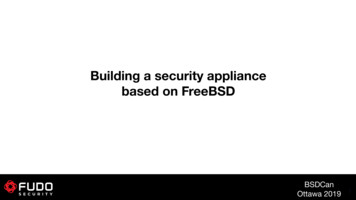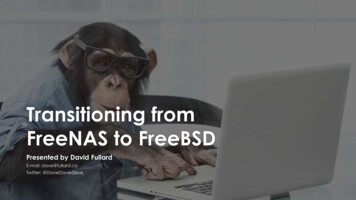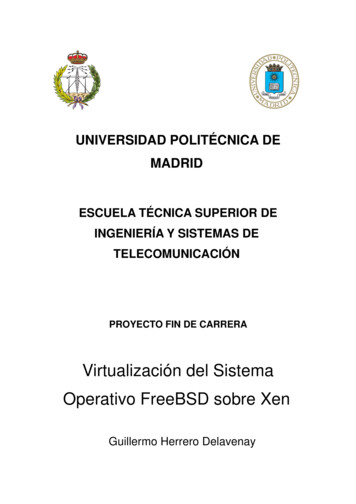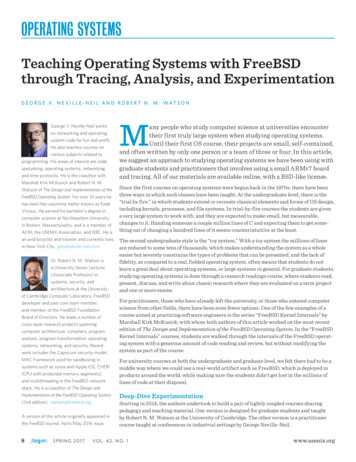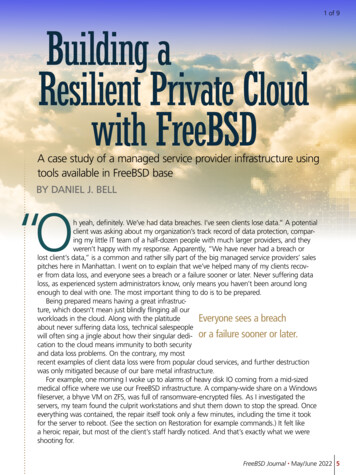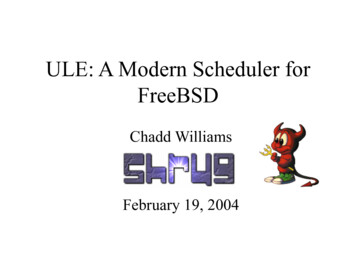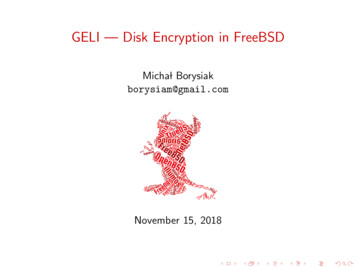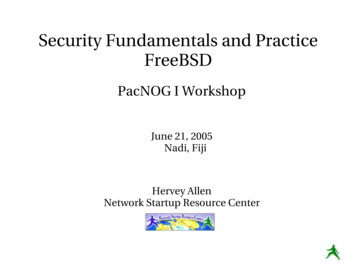
Transcription
Security Fundamentals and PracticeFreeBSDPacNOG I WorkshopJune 21, 2005Nadi, FijiHervey AllenNetwork Startup Resource Center
FreeBSD vs. LinuxSecurity models are almost identical, butactual implementation is a bit different.We include some FreeBSD-specific stepsand tips here.
Core security conceptsSet the stage. In the end you want to:Maintain confidentiality.Keep data safe from intruders.Integrity: protect from loss or change.AuthenticationIs this person who they claim to be?Is this person allowed access?AvailabilityAre our systems up and running?
Maintain confidentialityTo do this you need to have:Correct user and file permissions.Strong passwords.Trust in your users.Use of good cryptographic methods.
Keep data safe from intrudersRequires some effort:Keep people out who don't belong:Trust your users.Strong passwords.Limit services you run.Protect the services you do run.Encrypt data as needed.Backup data in case of intrusion orcorruption.Remember physical security.
IntegrityProtect your data against loss or change.Backup your data.Consider revision control.Intrusion detection systems (IDS).In the end is your data unchanged byothers? How can you tell?
AuthenticationHow do you ensure?:Someone accessing your system iswho they claim to be?Trusted users.Strong passwords.Public/Private keys.The person is allowed access?Maintain accounts properly.Correct user/group/file permissions.Scan and watch for SUID and SGID.
AvailabilityMake sure your server and services are up anddetect attacks like Denial of Service (DoS).Log what your services do and install log“watching” software.Setup notifications if there are problems.Scan for network attacks like spoofing(ARP), syn packet dumping, general packetsource address spoofing, brute forceattacks (dictionary password crackattempts).
Steps to takeRun only the services you plan on using.Use only the services that are necessary.Stay up-to-date and patchservices as needed.Use secure passwords andforce your users to use them.Consider if you need quotas.Restrict root access to services.Restrict access to services viatcpwrappers if appropriate.
Steps to take cont.Restrict access to your box using IPfirewall services (ipfw, ipf base system).Buffer overflow attacks. Be aware of them.Log events and understand your logs.Install intrusion detection software.Back up your server's data!Think about physical security.Test your security model.Don't forget about your clients.
A few resourcesThe FreeBSD mlChapter 14: SecurityClass reference book:Mastering FreeBSD and OpenBSD d/Security repository with references andexamples:http://nsrc.org/security/
Reduce the number of servicesWhat is being started at system startup?grep YES /etc/defaults/rc.donfgrep YES /etc/rc.confls /usr/local/etc/rc.d/etc/inetd.confDelete services you are not using.Change “YES” entries in rc.conf to“NO”Remove /usr/local/etc/rc.d startscripts.Comment out services in/etc/inetd.conf if inetd is running.
Reduce number of services cont.To see what is running you could use:lsof -i (if installed)netstat -an -f inetps -auxw moreSockstat -4fstat (with grep, read man page)Know what each and every item is.Simplify – remove any and all servicesyou are not using.
Use cryptographic methods toaccess servicesPOP/IMAP with SSL only.Consider TLS-Enabled SMTP.Remove Telnet replace with SSH.Remove FTP replace with SCP or SFTP.Anonymous FTP is OK, but be careful ifyou allow user uploads.Require HTTPS (HTTP over SSL) forsensitive information.
How to enforce good passwordsBy default FreeBSD allows for completely insecurepasswords. Test this using passwd as a user.You can use cracklib with Pluggable AuthenticationModules (PAM).Cracklib keeps a user from creating trivial passwords.You can find cracklib here:/usr/ports/security/cracklibYou should enable it here:/etc/pam.d/passwdRequires installing cracklib and uncommenting oneline in /etc/pam.d/passwd.
CracklibFrom “locate cracklib” under FreeBSD 5.4 afterinstallation cklib/pw dict.hwm/usr/local/libdata/cracklib/pw dict.pwd/usr/local/libdata/cracklib/pw kg/cracklib-2.7 2/var/db/pkg/cracklib-2.7 2/ COMMENT/var/db/pkg/cracklib-2.7 2/ CONTENTS/var/db/pkg/cracklib-2.7 2/ DESC/var/db/pkg/cracklib-2.7 2/ MTREE DIRSAs you can see cracklib is installed, a cracklibdictionary, and the PAM cracklib shared library.You can install via “pkg add -r cracklib” or bycompiling in /usr/ports/security/cracklib
More cracklibTaken directly from the cracklib README file:4) it's MIND-NUMBINGLY THOROUGH!(is this beginning to read like a B-movie flyer, orwhat?)CrackLib makes literally hundreds of tests todetermine whether you've chosen a bad password.It tries to generate words from your username andgecos entry to tries to match them against whatyou've chosen.It checks for simplistic patterns.It then tries to reverse-engineer your password intoa dictionary word, and searches for it in yourdictionary. ( million entries!)- after all that, it's PROBABLY a safe(-ish)password. 8-)
Other password checkersSome tools you could run against /etc/master.passwdafter password generation for more thoroughtesting.John the Ripper: http://www.openwall.com/john/Crack: http://www.crypticide.org/users/alecmFreeBSD's built-in PAM module pam passwdqc.You would create a cron entry to run a process againstsome/all user passwords once every certain period.“Cracked” passwords would generate an emailwarning to the user asking them to change theirpassword or be disabled.
Extra: more ways to control usersLook in to /etc/login.conf if you wish todefine login classes for your users tocontrol their access to resources.FreeBSD Handbook section g.htmlConsider file system quotas.FreeBSD Handbook section 16.14/usr/share/doc/en/books/handbook/quotas.html
Back up your server's data!Pretty hard to stress this more. If your securityis compromised what will you do without abackup? How many here do this?A few basic items to consider are:What needs to be backed up.How often do you need to backup?Where will your backup media be in case of disaster(fire, flood, earthquake, theft)?What happens in case of total loss?What tools will you use? Tar, Arkeia, cpio, dump, dd,rsync with ssh?
Tools to use for backupsArkeia: commercial /#backupsdd: convert and copy a file.man dddd if /dev/ad0 of /dev/fd0/bootsector.binbs 512 count 1Backs up a boot sector to a floppy.dd if /dev/fd0/bootsector.bin of /dev/ad0bs 512 count 1Recovers from floppy to ad0. Be very careful doing this!
Tools to use for backups cont.cpio: copy files to and from archives:cpitool: http://www.nickb.org/utils/man cpiodump: ext2/ext3/ufs filesystem backup.man dumprsync: remote copy.man rsync (not installed by default)tar: readman tar
A few practical backup tricksYou can use ssh and tar together to quicklybackup parts of your server. For instance, tobackup all /home directories to anotherserver as a single image:root@machine1# tar xzvf - /home/ \ssh machine2 “cat machine1-homes.tgz”Or, you can use rsync over ssh if you wish tokeep directories synchronized between twolocations. FreeBSD uses ssh by default withrsync:rsync -av . remote:/home/docs
rsync with ssh and ssh keysLater today we'll discuss ssh and the use of ssh keys toconnect to a remote machine without passwordsand use encryption.Image if in /etc/periodic/daily/ you set up a cronscript to do the following:rsync -a /var/www/html/ \backup.machine:/var/www/html/This recursively copies your root web documents to abackup machine using rsync via ssh. Note no “v”(verbose) option was used.If you use the “--delete” option in rsync, then filesremoved on your local machine would be removedon the remote machine as well when you run this.
Log events and understandyour logsThis is time consuming – even with the manytools that are available.You need to go through each service runningand decide if you want to log events from thisservice. This has already been partially donefor you in /etc/syslog.conf under FreeBSD.Ideally logs should be created or saved off yourserver. A cracker will alter your logs to covertheir tracks.
Networking monitoring/loggingA few useful network monitoring tools:Nagios: monitors services running on hosts on yournetwork as well as resources. Can monitor you of eventsvia email, pager, etc. Find this at http://www.nagios.org/.nmap: network exploration tool and security scanner canidentify machines and services on your network. Find thisat http://www.insecure.org/nmap/.ntop: from http://www.ntop.org/ gives full featuredprotocol analysis of who's talking to whom on yournetwork. Includes graphical reports and web interface.httptop: can give you real time monitoring of your webtraffic. Find this from http://examples.oreilly.com/.Caveat: these tools can get you in trouble. Besure you have permission to run them.
Patching your softwareAs needed download patches for the servicesyou run. You should be notified of these viathe mailing lists mentioned.For your OS the vendor will often providespecific patches or update installers.For FreeBSD the FreeBSD project willprovide port updates or new packages.Or, use cvsup and ports. If software is a portand it is patched, then a simple “make” in /usr/ports/category/package/ may do thetrick.
Where to find some securitymailing listsGeneral security mailing lists:BugTraq: http://www.securityfocus.com/CERT: http://www.cert.org/Rootshell: http://www.rootshell.com/For Apache, Bind, Exim and SSH:http://www.apache.org/http://www.isc.org/ reeBSD Security Notifications Mailing List:- security-notifications
Think about physical securityAll the security in the world does nothing against adisgruntled employee, server sitting out in the open,people who copy keys, and so on.Backups: where do you physically keep your them? Whohas access to them. Are they separate from your server?Logs: are they on a separate and physically secure logserver? Printed to a separate printer?Bootloader password and encrypted files: what happensif someone walks off with your machine?! Or, howabout just the hard drive(s)?Physical access total access
Consider if some services shouldrun under the inetd tcpwrapperAccess control for services is done in /etc/hosts.allow (hosts.deny isdeprecated)./etc/inetd.conf determines whatservices will run under the inetdwrapper.Enable /etc/inetd in /etc/rc.conf with:inetd enable ”YES”What does inetd provide?
What does inetd provide?The inetd daemon (service) listens fornetwork packets for each service started in/etc/inetd.conf.inetd saves on memory and resources as aservice is only started if a packet arrives for it,but it's better not to use inetd for a loadedservice like http.You can control how packets arrive or don'tarrive on a service-by-service basis in adetailed manner using inetd.
inetd vs. ipfwNote: FreeBSD doesn't use xinetd.ipfw permits full control over packets arriving for aservice or server.ipfw provides a more complete ruleset that you canapply to a service, including more fine-grainedcontrol over icmp and udp packets.ipfw is part of the kernel, thus it is more efficient.inetd has (imho) an easier syntax to understand.inetd can send messages for rejected items.
More inetd informationIf you are interested in all the parametersyou can specify on a service-by-servicebasis in both /etc/inetd.conf and/etc/hosts.allow, and when you start theinetd daemon, then see:man inetdman hosts accessman hosts options
Automated loggingTo configure what is logged read “mansyslog.conf” for full details on how this file isformatted.FreeBSD sends a daily summary of events andsystem status generated by cron to root bydefault.Consider using a central logging server. Youcan use /etc/syslog.conf to send events toanother server via your network.
Yet more logging.A few useful tools to monitor activity:Swatch: Simple WATCHer is available fromhttp://swatch.sourceforge.net/ or in the port collectionin /usr/ports/security/swatch. Will watch for “trigger”events in your logs and notify you immediately.syslog and periodic: see “man syslog” and “manperiodic” to understand how daily log and systemactivity summaries are generated in FreeBSD.See http://nsrc.org/security/#logging for some moretools.
Consider if you need to use quotasFreeBSD Handbook section 16.14 and Chap. /share/doc/en/books/handbook/kernelconfig.htmlDo you trust your users?What happens if /tmp or /usr (/usr/home)fills?Are you using anonymous ftp?Are these on separate disks or partitions?If not, you might want quotas.Practical quota tips
Practical quota tipsGeneral Steps to Activate:Recompile kernel with “options QUOTA” inyour kernel configuration file.Enable quotas in /etc/rc.conf with:enable quotas ”YES”Enable group and/or user quotas in /etc/fstab:/dev/da1s2g/homeufs rw,userquota,groupquota 1 2Use edquota to update the quota.user andquota.group files in the root directory of eachquota-enabled file system.Commands include quota, quotaon/quotaoff,quotacheck, edquota.
Restrict root access to a minimalset of servicesCheck for files with setuid/setgid bitsrunning as root. If you don't need thesefiles, or users don't need to run them,then remove this bit (chmod 000)Consider running a service in a“sandboxed” environment using chroot.Consider running a service under adifferent userid if possible.Practical restriction tips
Practical root restriction tipsTo find all files with setuid or setgid bitsset on a machine you can do:find / -perm 6000 -type f -exec ls -ld {} \; setuid.txt &You'll have a file listing all setuid/setgid files (but notscripts) on your machine.You can turn off setuid or setgid bits by doing either:chmod 0nnn filenamechmod 0000 filenameBe aware of what your changes imply. FreeBSD5.4 ships preconfigured with many setuid &setgid files and warns if additional files areset.
Practical root restriction tips cont.Use chroot to run services with their ownroot directory – i.e. in a “sandbox” or“jail”.You can use the FreeBSD jail facility.Several services already run “sandboxed”by default, including ntalk, comsat, andfingerThe named service has configurationoptions in /etc/defaults/rc.conf.See FreeBSD Handbook 14.3.2 for moredetails.
How apache runs as user “apache”Taken directly from /etc/httpd/conf/httpd.conf:# If you wish httpd to run as a different user or group, you# must run httpd as root initially and it will switch.## User/Group: The name (or #number) of the user/group to run# httpd as. . On SCO (ODT 3) use "User nouser" and "Group# nogroup". . On HPUX you may not be able to use sharedmemory# as nobody, and the suggested workaround is to create a user# www and use that user.# NOTE that some kernels refuse to setgid(Group) or semctl# (IPC SET) when the value of (unsigned)Group is above 60000;# don't use Group #-1 on these systems!#User apacheGroup apache
Buffer overflow attacksA Cracker pushes more data on to a servicesbuffer than space provides. They can “breakout” of the program space and executearbitrary commands on your system with theprivileges of the compromised service.Many security patches deal with newlydiscovered buffer overflow holes.The Linux world has several solutions for this,but also has more problems with this issue.
Configure and use an IDSIntrusion Detection System IDSNetwork Intrusion Detection System NIDSAnd, System Integrity Checking is a genericterm for this.An IDS monitors network traffic and warns ifsuspicious behavior is detected.A System Integrity Checker looks for changesto files that are not expected and warns youof these.For a list of many tools seehttp://nsrc.org/#integrity
Snort intrusion detection systemSnort from http://www.snort.org/ is a very populartool to detect unexpected network events using aknown set of rules and patterns. This is a signaturebased IDS. We will be using Snort tomorrow.Additional Snort add-ons include:ACID: Anaylsis Console for Intrusion Databases. Web frontend to IDS alert database(s). Good for large site. Fromhttp://acidlab.sourceforge.net/.Sguil: Snort GUID for Lamerz. Complex system to analyzepossible IDS events with tools such as ethereal and TcpFlow aswell as Snort. From http://sguil.sourceforge.net/.Snort inline: from http://snort-inline.sf.net/. Detectintrusions and react to them.SnortSam: from http://www.snortsam.net/ to update firewallson the fly to deal with attacks.
Restrict access to your box using IPfirewall services (ipfw)FreeBSD 5.4 ships with no less than three“ready-to-go” firewall solutions. These are:1.) IPFIREWALL: or ipfw. Version 2, or ipfw2,comes with FreeBSD 5.4. Sample (outdated)ruleset in /etc/rc.firewall if installed.2.) IPFILTER: or ipf (the “Handbook's pick”).3.) Packet Filter Firewall: or pf from theOpenBSD project.Detailed discussion can be found in:/usr/share/doc/en/books/handbook/firewalls.html
Firewalling cont.From the Handbook:The configuration of the IPFW software is done throughthe ipfw(8) utility. The syntax for this command looksquite complicated, but it is relatively simple once youunderstand its structure.There are currently four different command categoriesused by the utility: addition/deletion, listing,flushing, and clearing. Addition/deletion is used tobuild the rules that control how packets are accepted,rejected, and logged. Listing is used to examine thecontents of your rule set (otherwise known as the chain)and packet counters (accounting). Flushing is used toremove all entries from the chain. Clearing is used tozero out one or more accounting entries.
Firewalling cont.To use ipfw you should place ipfw rulesetsin /etc/rc.conf.Logging is recommended when you firstbuild your ipfw ruleset to help debug whatyou are doing.A couple of example ipfw rules:ipfw add deny tcp from evil.doers.org to nice.people.org 22ipfw add deny log tcp from evil.crackers.org/24 to nice.people.orgWe explain these on the next page
Firewalling cont.This command will deny all packets from thehost evil.doers.org to the ssh port of the hostnice.people.org:ipfw add deny tcp from evil.doers.org to nice.people.org 22The next example denies and logs any TCPtraffic from the entire crackers.org network (aclass C) to the nice.people.org machine (anyport).ipfw add deny log tcp from evil.crackers.org/24 to nice.people.org
Firewalling cont.Before starting:Read FreeBSD Handbook on ipfw and/or firewallsRead “man ifpw” - “man ipf” - “man pf”See pf's comprehensive user guide here:- http://www.openbsd.org/faq/pf/- Setting up a useful and functioningruleset can be quite complex.- The FreeBSD Handbook's firewalldiscussion is excellent and you shoulduse this.
Test your security modelConnect to your machine(s) externallyand see if your model works!Run some security scanning softwareagainst your machine.A common tool is nmapAnother tool is Nessus, which we'll usenext.See:- http://www.insecure.org/nmap/- http://www.nessus.org/.
Test your security model: nmapWarning! Don't run nmap against machines ornetworks without giving prior notice!Now try scanning your neighbor's box:nmap 202.62.122.nnnnmap -O 202.62.122.nnnnmap -sS -O -p 1-1024 -v \202.62.122.nnnRead the nmap man pages to figure out what'sgoing on, and a decent nmap lechtner.html
Don't forget about your clientsMake sure that your users must connect to your servers insuch ways as to help ensure the integrity of their dataand their user accounts.Insist on software clients that use encryption like SSH vs.Telnet, SCP/SFTP vs. FTP, POP/IMAP over SSL.Human clients running their OS'es. Dealing withWindows security issues such as viruses, WindowsUpdates, worms, spyware, etc.Virus scanning software to defang email on your server?Scripts as well – can rename files like .exe, .pif, .com, .scr, .vbs, .bat to fn.ft.txt.Social issues. Security is inconvenient. For instance,Windows still does not ship with SSH – This is painful.Later we'll look at Windows XP and 2000 practical security tips.
Some resourcesCERT (Coordinated Emergency Response Team)http://www.cert.org/ and http://www.us-cert.gov/cas/index.htmlNice List of Security Resources for curityTools.htmlnmap: Network exploration tool and security scannerhttp://www.insecure.org/nmap/O'Reilly Bookshttp://www.oreilly.com/SANS Computer Security and Mailing Listshttp://www.sans.org/ and http://www.sans.org/newsletters/risk/Security Documents from nsrc.orghttp://nsrc.org/security/ and http://nsrc.org/freebsd-tips.htmlAnd, don't forget your own local help at http://www.sanog.org/!
More resourcesThe FreeBSD Handbook Security Sectionhttp://www.freebsd.org/doc/en US.ISO8859-1/books/handbook/security.htmlFreeBSD Website “intrusion detection” Softwarehttp://www.freebsd.org/cgi/ports.cgi?query intrusion detection&stype allFreeBSD Security Notifications Mailing bsd-security-notificationsNessus Security Auditing Packagehttp://nessus.org/
ConclusionMore security means less convenience,but a security breach can be the leastconvenient moment of all.There is always a tradeoff between howmuch security you put in place andwhat services you are providing.Your users may grumble, but they'll reallygrumble if their data is compromised –Remind them of this :-)
Make sure your server and services are up and detect attacks like Denial of Service (DoS). Log what your services do and install log fiwatchingfl software. Setup notifications if there are problems. Scan for network attacks like spoofing (ARP), syn packet dumping, general packet source address spoofing, brute force
